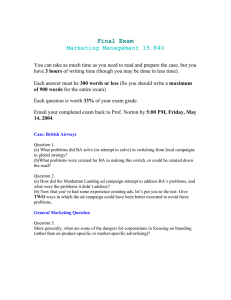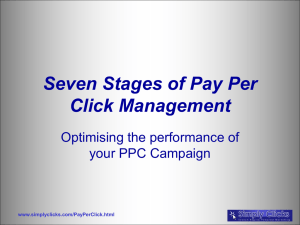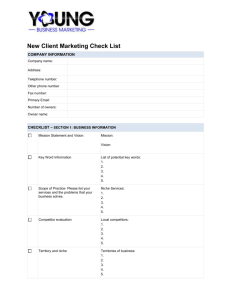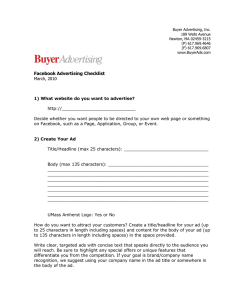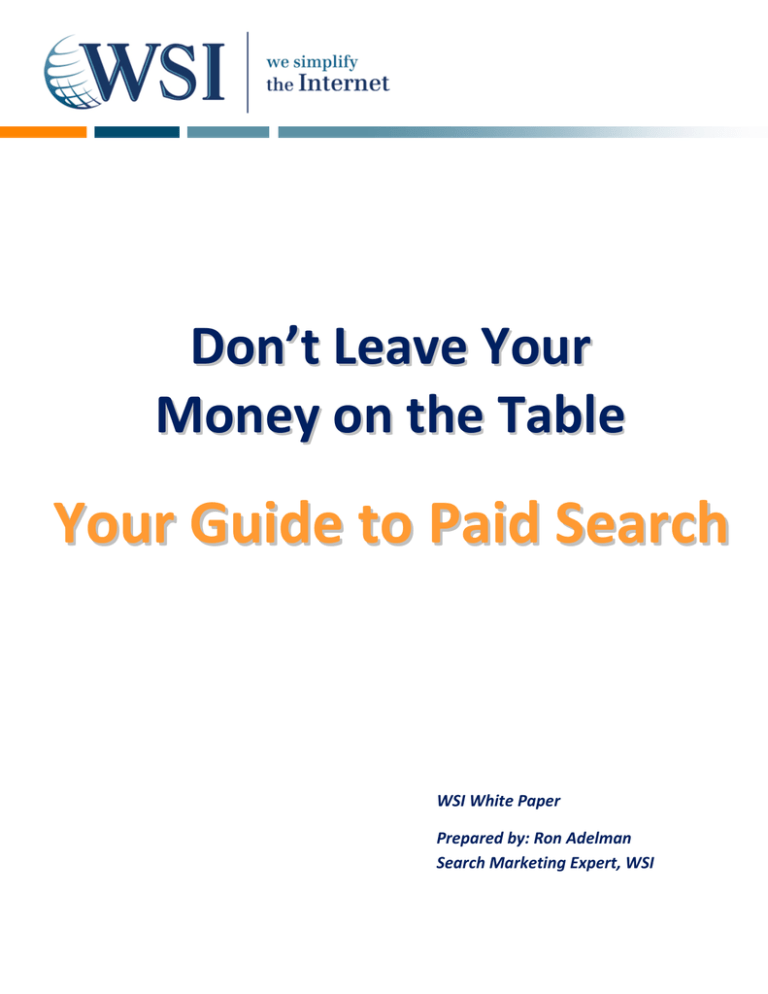
Don’t Leave Your Money on the Table Your Guide tto P
Paid Search
WSI White Paper Prepared by: Ron Adelman Search Marketing Expert, WSI Don’t Leave Your Money on the Table Your Guide to Paid Search Introduction When was the last time that you looked online for a product or service? What stood out to you and did you visit the website to make a purchase? If you did, then your habits are in line with 85% of the world who use the internet to make a purchase. Online shopping has increased by over 40% in the last two years according to Nielson’s Global Online Survey. That’s over 875 million consumers! Think of all of those opportunities for new business. If you aren’t taking advantage of them, then you should be and you’re leaving money on the table…. Paid Search or Pay‐Per‐Click (PPC) advertising is an effective and powerful marketing tool that allows your company to create online brand exposure to your target markets. Additionally, PPC gives you ultimate control over your marketing dollars while allowing you to capture the attention of the booming number of online consumers who are ready to spend money on your products and services. You just need to be there. It’s like having an ad in your local newspaper and only paying for the prospects that read it! How can it get any better than this in advertising? Online Advertising Spend – Trends Increasing Remember the 875 million people that was just mentioned? The figure below will show you the latest trends in online advertising spend and how it has increased since 2001. You’ll notice that the amount of money spent directly on paid search correlates with the growing number of online consumers, which will continue to skyrocket. Now, compare that figure to what you are currently spending on print advertising. The difference is astounding, isn’t it? Copyright © 2009 by Research and Management. All rights reserved. Page 2 of 13 Don’t Leave Your Money on the Table Your Guide to Paid Search The driving force behind shifting advertising spend is attributable to the growth in search volume and the tracking and refinement that only paid search marketing allows. To the very keyword or ad we can track the effectiveness of our campaign and improve targeting and spend. No other advertising mediums are as accountable for performance as online sources. For companies seeking more website traffic, paid search marketing offers an opportunity for immediate results. You can instantly get to the top of the Google, Yahoo!, or MSN, and access precisely targeted traffic that is likely to transition to real customers for your business. Paid Search Marketing or PPC Marketing Paid search marketing, also called pay‐per‐click (PPC) marketing, is a method of advertising when a user searches for one of your keywords, through paid online ads that link to a landing page of your choosing. Usually labeled as “Sponsored Links” or “Sponsor Results,” these ads appear just above or to the right of the natural listings, known as organic search results. Copyright © 2009 by Research and Management. All rights reserved. Page 3 of 13 Don’t Leave Your Money on the Table Your Guide to Paid Search Paid search ads can be purchased through any of the major search engines, including Google, Yahoo, and MSN. These engines receive the great majority of search volume, with Google’s share being considerably larger than the other two. This paper will focus mostly on Google because of its market share, as well as the control and tracking ability of tools in AdWords, Analytics, and Webmaster Central. Copyright © 2009 by Research and Management. All rights reserved. Page 4 of 13 Don’t Leave Your Money on the Table Your Guide to Paid Search Goal of Your Campaign Before you begin your campaign you first need to identify, “What is it that I want to accomplish with buying clicks?” Typical goals of a paid search campaign: • Sell products or services • Get leads direct email or calls • Increase website membership or RSS / e‐newsletter subscriptions • Establish a brand Once you’ve clearly identified your goals, make sure your website and its conversion architecture funnel your visitors to these goals. By far the most common mistake first time advertisers make is not being honest with themselves about the landing page and website. Review your competitors’ sites—which would you buy from and why? Make it simple for your users to accomplish your goals, give them plenty of incentive, remove their fears and “roadblocks,” and answer their questions. Know Your Audience Knowing your audience allows you to specifically target your keywords, ad text, landing page and conversion funnel to speak directly to that audience. The more customized your message can be, the more “roadblocks” you can remove. Gaining more targeted clicks will maximize your marketing dollars for your core demographic. Targeting: Limit the visibility of your ad based on the theoretical audience and their likely online behavior. Geo Targeting: Many businesses only serve customers in a certain geographic areas. Select only the areas you are willing to sell. Alternatively, if your budget is limited, market only to areas where you have the best conversion, highest margins, or prefer to work. This can be narrowed to a 10 mile radius or custom inclusion area. In other words you can target an area, like delivering pizzas only in the area you want to and having the ads only show up in that area! Copyright © 2009 by Research and Management. All rights reserved. Page 5 of 13 Don’t Leave Your Money on the Table Your Guide to Paid Search Search Network or Content Network: Do you want to advertise on Google only or 3rd party websites with content “matching” your keywords? The content network can result in cheaper clicks but with less targeted traffic, as we are letting Google determine relevance of 3rd party content to our search terms. Determining when and how much to bid on the content network will be something you’ll want to track and Google also provides the analytics for this tracking. Day‐parting: When your audience tends to use the Internet during certain hours or days of the week, deactivating your ad during off‐peak times can reduce your irrelevant traffic. This is particularly helpful for business to business companies that get targeted inquiries during the work week, 9 a.m. to 5 p.m. The inverse can be true for those gaining most of their business evenings and weekends. Copyright © 2009 by Research and Management. All rights reserved. Page 6 of 13 Don’t Leave Your Money on the Table Your Guide to Paid Search Keywords: Getting ass targeted as possible with
h your keyword selection ccan make thee difference between a miserablee failure and aa very producctive campaiggn. Restrict yo
our potential audience as much as posssible without eexcluding the majority. • Find thee bargain phrase variations that receivee a high searcch volume butt don’t have n
numerous compeetitors biddingg on them. • Filter ou
ut what are known as negaative keyword
ds, or search terms that co
ome close to phrases you’re biddingg on, but indicate a completely differen
nt concept or type of busin
ness. This takes some tho
ought, but anaalytics again h
helps you herre. • Example: If you are bidding on “d
desks” or “offfice desks” an
nd all of your products aree made of woo
od, you sho
ould add “me
etal” as a negative keyworrd to filter outt searches forr metal deskss. Matchh Type: You can choose Exact, Phrase, or Brroad Matchin
ng to choose h
how closely a typed phrasee has to matcch your keyw
words in order for your ad to be displayyed. Example: Broad Matching on the w
word “desk,” yyou would geet impressions for “metal o
office desk,” aas well as “w
wood desk” orr “desk for ho
ome office.” B
But lower landing page relevance and ccompetition from Exact Mattches for “me
etal office dessk” would drivve your bid prices up. Pluss, if the landin
ng page doesn
n’t match thee search term
m, many people will leave tthe page wheen they don’t find what theey want right away. This is why exhaaustive multi‐word keyworrd phrase listss can help low
wer prices and
d bounce ratees. You can d
determine bad
d matches in Google’s Search Query Reeport or with advanced weebsite analyticcs. Copyyright © 2009 b
by Research and Management. A
All rights reserveed. Page 7 of 13 Don’t Leave Your Money on the Table Your Guide to Paid Search Ad Text: Write compelling ad text that lets a search user know, “This is exactly what I was looking for.” Specific descriptions also help decrease irrelevant traffic, which prevents you from wasting money on clicks that don’t translate into sales or leads. Google allows you to rotate ad text for your ad group effectively providing you A/B testing to determine which ad text is getting more clicks and more importantly more leads. Selectively pulling messages that aren’t working will move your campaigns to the next performance level and help drive positive changes to your sales and marketing messages. Adding phone numbers, pricing, competitive advantages all seek out the right potential lead to click. Landing Page: By keyword you can land your traffic on your site’s most relevant information or highest conversion area. It is also possible to test unique landing pages which are customized for specific search terms and only visible to PPC customers, enhancing your ability to track results. For instance, displaying a unique phone number (call tracking), on a PPC landing page can help identify which incoming calls originated with paid ads. We can even record the calls off your specific landing page for our clients to follow up on. Google also provides A/B or multi‐variate landing page testing to help you improve your landing pages ensuring their conversion potential. Google Website Optimizer Experiment Copyright © 2009 by Research and Management. All rights reserved. Page 8 of 13 Don’t Leave Your Money on the Table Your Guide to Paid Search Budget: How much are you willing to spend to acquire a new customer? Budgeting for campaigns and keyword bids requires a thorough understanding of paid search; otherwise returns will suffer and advertisers begin to doubt the value of this medium. Although you can change your budget at any time if you find it’s not working for you, you can use this simple calculation to help you find a good starting place for your daily budget. • Decide what you are willing to spend for a goal being met. Think about what your usual cost per lead is in other forms of advertising like direct mail, networking, radio, print, or billboard. • Estimate how many completed goals or sales you expect or want to get in one month as a result of your PPC campaign. • Multiply your expected individual cost by anticipated number of sales. • Divide that total by 30 days to get your daily budget. Your budget can also be divided proportionally so certain keyword phrases get a higher daily spend, and less important or experimental phrases will have a more limited spend. Frequency of ad delivery can be adjusted as well, either spending your budget as quickly as the search volume allows or spacing out your ad impressions to make sure there is at least some visibility for your site over the full course of the day. Keyword Bidding: When setting up your campaigns, Google, Yahoo, and MSN will provide estimates on what you need to bid to achieve a certain position for each keyword phrase. You can apply one amount to an entire ad group or change bids by individual keyword. Your bid amount determines your placement on the page, and ads are ranked top to bottom in order of bid amounts. Higher placement will get you more clicks, but there can be a downside. Increased cost per click may be detrimental to your return on investment (ROI), and the bounce rates for the top three ads tends to be higher as they receive more casual search traffic we call the “Happy Clicker”. By using an analytics program to closely monitor your sales or lead values, and dividing that by your keyword cost per click, you can keep an eye on each phrase’s ROI and determine if higher placement is worth it. Conversion and Analytics Tools: Just like a traditional marketing campaign, PPC marketing needs to be tracked and have its success rate evaluated. Each element of the campaign is studied and tested to determine the impact on the rate of conversion from ad views to ad clicks to final goals met. Areas of success can be expanded and the pieces that aren’t productive can be tweaked or eliminated altogether. This ongoing process of campaign refinement uses web analytics, tools that give you information about user activity and help make search marketing decisions. Copyright © 2009 by Research and Management. All rights reserved. Page 9 of 13 Don’t Leave Your Money on the Table Your Guide to Paid Search The most popular analytics tool in search marketing is Google Analytics, which is completely free and usually more than adequate for managing online business. The program directly integrates with Google AdWords, and tracking information for Yahoo, MSN, and other properties can easily be input as well. If you opt in and allow your information to be included, you can access industry comparison data. As the number of companies using AdWords has increased, their metrics have gotten very accurate and incredibly useful. By using analytics tools to improve your campaigns, PPC marketing will become more profitable over time. As you adjust the structure of your ad groups and budgets, edit your ad text, and add very specific longer keyword phrases, you will see consistently increasing ROI for every dollar you spend. WSI Case Study: Management of AdWords Using Analytics We were hired by a nationwide business broadband provider targeting small to medium businesses as well as enterprise level clients in Nov. 2006. They had been managing their own paid search marketing internally and were seeing diminishing returns and made a decision to outsource. Our plan to increase overall efficiency centered on gaining lower cost qualified traffic with increased conversion rates. These key aspects paid big dividends for the client. Featured below are some of the key metrics we use to measure our success. Copyright © 2009 by Research and Management. All rights reserved. Page 10 of 13 Don’t Leave Your Money on the Table Your Guide to Paid Search Agency Management Someone will inevitably bring up the question, “Why don’t we just manage this ourselves?”—and you can. The next question should be, “Do we have someone that we can devote full time to learning not only the basic functionality of the various engines, but have daily vigilance of bids, ads, landing page effectiveness, visitor behavior, and conversion tracking?” Many companies have tried to use one of the paid search models with internal staff and have determined, “it doesn’t work for us”. More than likely the task was given to a technical person (someone comfortable editing the website) or a traditional marketing person. However, offline marketing is not the same as online marketing and trying to get your IT person to market when they are already overburdened with technical tasks will only cost you more money. Maybe this has been your experience! “Campaigns that were profitable years ago are no longer profitable,” is another common complaint we hear from companies. Because paid search is no longer new and competition is fierce for profitable niches, adaptive management is the only way to maintain ROI. Actively tracking your cost per conversion will let you determine trending in your industry, landing page effectiveness, and bid strategies that work best for your industry. Copyright © 2009 by Research and Management. All rights reserved. Page 11 of 13 Don’t Leave Your Money on the Table Your Guide to Paid Search Top Five Reasons Companies Must Consider Paid Advertising in a Slow Economy 1. Targeted marketing. You don’t have time to waste pitching to consumers who may have no need for the products or services you provide. 2. Instant traffic. Acquiring inbound links and domain credibility to move up in the organic results can take awhile. Paid search offers a quick ticket to immediate visibility, and can be especially helpful for new and small businesses facing competition with national chains and long‐established brands. Local Ads Sell! 3. Marketing during the purchase phase. Impulse shopping is out. Buyers are thoroughly researching and performing price comparisons on even small purchases. With PPC marketing and custom landing pages, you can include specific messaging and resources that give consumers the information they need. 4. Measured budgets. Only spend what you can afford. As sales and your profits increase, you can adjust your PPC budget accordingly. 5. Higher conversion rates. The number of sales and leads you’ll get per dollar spent in PPC marketing exceeds the averages for traditional media like direct mail or telemarketing, TV and radio. Newspaper, Trade Shows, and Magazines are hard to measure. Work With WSI to Maximize Your Paid Search ROI
Developing and maintaining a paid search campaign requires constant attention and analysis. Selecting a long list of keyword phrases and letting the costs accumulate may increase sales, but at a much higher cost than is necessary. By investing in PPC management services and targeting your advertising spend, your budget can stay the same while your sales increase and awareness of your brand builds a solid foundation for your company’s future. In tough economic times, the highly‐qualified, relevant traffic you need can be brought to your front door. Let WSI apply our wealth of paid search management experience to your advertising campaigns. We’ve spent years learning and mastering the PPC back‐end systems of Google, Yahoo!, and MSN—detailed and complicated tools that are updated and changed regularly. Focus your attention on your business and let us bring you new customers. We even have proprietary software that gets smarter with each click honing in on the leads that covert! Very compelling reasons to use a WSI Consultant... Copyright © 2009 by Research and Management. All rights reserved. Page 12 of 13 Don’t Leave Your Money on the Table Your Guide to Paid Search About the Author Ron Adelman is a Search Marketing Specialist at WSI who really knows the ins and outs of the Internet industry. He has spoken at several dozen events, including global Internet marketing conventions, training workshops and events organized by the American Marketing Association and the Direct Marketing Association. If you have any questions, please email education@wsicorporate.com. Glossary of Pay‐Per‐Click Terms To fully grasp the concept of PPC marketing, you need to know a few important terms. By learning the lingo, you can properly communicate your business needs, give specific input on how the campaign is set up, and understand the value that paid advertising brings to your company. Keyword Phrase: The string of text a user enters into a search engine. PPC (pay‐per‐click): An advertising model in which sponsors acquire online ad space, but are only charged by the host when a search user clicks on the ad. Impressions: The number of times your ad has been produced in search results. Clicks: The number of times a search engine user has clicked on your ad and been taken to a landing page on your website. CPC (cost per click): The actual amount you are charged for each click. Average CPC: The average of your CPC over a set period of time. CPC is usually represented as an average number, since the individual click costs will vary depending on changes in your maximum bid and competitor campaign changes. CTR (click‐through rate): The percentage of impressions that generated ad clicks. Landing page: The web page delivered to search users who click a particular ad. Conversion: A specific behavior that the search user completes that matches a goal set by the sponsor. A goal could be an e‐commerce sale, contact form submission, newsletter subscription, or specific series of page views. Conversion rate: The percentage of ad clicks that resulted in completed goals. Quality score: A ranking given to your ads by Google that take into consideration your CTR, landing page relevance, and domain trust that is used in determining CPC and level of placement in the results. Copyright © 2009 by Research and Management. All rights reserved. Page 13 of 13

